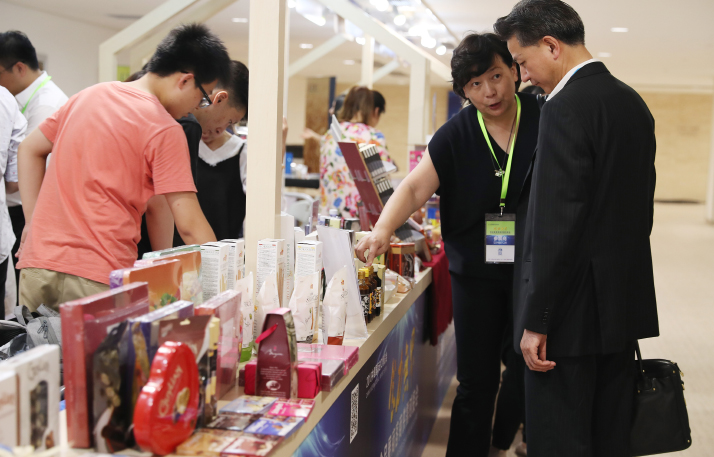| Business |
| Foreign Foods to Land on Chinese Dinner Tables Faster | |
| As the country continues to reduce import tariffs and simplify customs clearance processes, it will take much less time for foreign foods to make their way to Chinese dinner tables | |
|
|
 Exhibitors introduce their food products at a warm-up event of the China International Import Expo in Shanghai on June 14 (XINHUA)
On July 1, China cut import tariffs on certain daily consumer goods. The average tariff rate for cultured and fished aquatic products was cut from 15.2 percent to 6.9 percent. As the country continues to reduce import tariffs and simplify customs clearance processes, it will take much less time for foreign foods to make their way to Chinese dinner tables. For example, a batch of fresh milk leaving a New Zealand farm on July 1 can now reach Chinese homes as early as July 3, a process that took eight days at the beginning of the year. Lobsters, salmon, oysters and other fresh seafood from Canada can arrive in China's first-tier cities within 36 hours, thanks to China's trade facilitation policies and its rapid development of cold-chain transportation. The customs clearance time has been reduced to less than 2 hours in several major Chinese cities including Shanghai, Beijing and Guangzhou. "We now guarantee our lobsters fresh and alive when they arrive on Chinese customers' doorsteps. If not, they can reject the package on site," said Leo Liu, General Manager of Canada's 50N Natural Ecology Group Ltd. The tariff cut can make the company's products more competitive in China, he said. Currently, few Canadian aquatic product and food enterprises have made China a major export market, since their traditional export markets are the United States and Europe. Liu's company has opened online shops on Chinese leading e-commerce platforms, but the sale volume only accounts for 5 percent of the company's total. "Canada's food trade with China is mainly grain, oil and other commodities. With China's import tariff cuts, we will be selling more consumer products to China to catch up with the country's upgraded consumption habits," said Liu. Food traders are preparing to increase iced imports of fresh and frozen foods to the Chinese market. Ye Zi, chief business officer of H&M (Shanghai) Trading Co. Ltd., said the company has started to import frozen aquatic products from Japan for the first time. "Frozen aquatic products have a shelf life of eight months. Since the whole customs clearance process is limited to two weeks, it is now possible to sell imported frozen aquatic products in China," said Ye. Milk produced by New Zealand brand Theland can land in Shanghai's supermarkets and China's e-commerce platforms roughly 72 hours after production and bottling near Auckland. The process used to take five days, said Sheng Wenhao, Chairman of the Board of Theland New Cloud Digimart, which owns the brand. He said that trade facilitation has made it possible to sell imported pasteurized milk in China, which has a shelf life of 15 days. Earlier this year, the Shanghai Entry-Exit Inspection and Quarantine Bureau and the government of Changning District, home to the city's biggest Japanese and Korean communities, launched a trial scheme to speed up import inspection. Theland and four other brands, rated by municipal regulators as having reliable quality and good reputations, were "fast tracked" for import quarantine and inspection. The eight-day customs clearance time of Theland milk was reduced by more than half. Chocolate—an imported product that has seen China's opening up and consumption upgrade—reflects the changes carried out during this round of trade facilitation. The Shanghai Maxmile International Trade Co. is the general agent of several famous chocolate brands including Guylian in China. Wei Wenzhong, General Manager of the company, said that Chinese customers now have more diversified demands for flavor, locality and roasting methods. Moreover, he said shea butter, while popular around the world, is still new to Chinese consumers. Chocolate with shea butter ingredients used to be blocked in China because shea butter did not have a Harmonized System (HS) code, which is an internationally standardized system of names and numbers to classify traded products. "Last month, shea butter got its official HS code, and Chinese customers will be able to taste chocolate with shea butter soon," said Wei. "More food and ingredients will be added to the HS. Our new products such as golden berry chocolate will also enter the Chinese market soon." The company, along with many others, has benefitted from the Shanghai Municipal Government's accelerated work on HS authentication. With Shanghai scheduled to host the First China International Import Expo in November, the municipal government has accelerated the removal of restrictions and delays brought by HS codes. "Shanghai encourages new and innovative products. We have implemented pre-inspection policies for the market debut of new products, which will enable a speedy passage through customs upon arrival. The new measures will allow new products to be sold here even without proper classification for the moment," said Kong Fuan, head of the Business and Trading Office of the Shanghai Municipal Commission of Commerce. This is an edited excerpt of an article published by Xinhua News Agency Copyedited by Rebeca Toledo Comments to zhouxiaoyan@bjreview.com
|
|
||||||||||||||||||||||||||||||
|